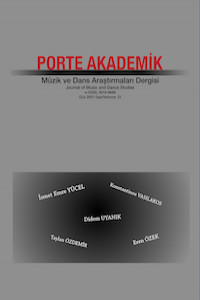Abstract
The development of music analysis as a theory date back to the late 19th century. While these theoretical approaches explain the elements related to the internal organization of music only at its own level, interpreting styles that have become closer to other disciplines over time have brought new levels to music analysis. These studies, which deal with the relationships of music with semiotics, linguistics, and hermeneutics, mostly appear in the 20th century. Musical semiotics arises from such a close relationship with linguistics and semiotics. What distinguishes semiological analysis from other methods of analysis is primarily the discipline it is backed by and the terminology it uses. In addition, it tries to draw the analysis models of the discipline with which it is related to the analysis level of music.
In this article, the studies in the field of musical semiotics will be mentioned and applicability of the approach of Jean-Jacques Natttiez will be explained. The English translation of his book published in 1990 and other publications will be used as the main source. Nattiez's approach, which utilizes both semiotics and linguistics, includes the process (poietic) and reception (esthesic) by which the work is shaped in the hands of the composer, without relying on a pure analysis of the work (neutral), unlike most of his contemporaries. It offers a three-level approach, namely poietic, neutral and esthesic. The neutral level is seen as a controversial level in some respects due to the analysis style it presents and it focuses on work analysis. In the article, these aforesaid opinions will be discussed and the scope of these three levels will be explained in general. Until now, analysis object of musical semiotics, including Nattiez's work, has mostly been the tonal works of Classical Western music. Although tonality provides a very favorable environment for some semiotic readings in terms of making certain relationships necessary, there is no claim that these studies cannot be applied to a non-tonal structure. Therefore, it will be discussed that Nattiez's approach, which gives priority to emphasize the social meaning of the musical work, should not be limited to tonal music, it can be transferred to other mediums.
References
- Agawu, Kofi V. 2009. “Music as Discourse: Semiotic Adventures in Romantic Music”. Oxford Studies in Music Theory, England: Oxford University Press.
- Barthes, Roland. 1993. Göstergebilimsel Serüven. Sema Rifat, Çev. İstanbul: Yapı Kredi
- Cook, N. 1994. A Guide To Musical Analysis. Oxford: Oxford University Press.
- Dunsby, J. 1983. “The Nattiez Phase”. The Musical Quarterly, 69 (1), s. 27-43. Oxford:1983
- Gür, T. 2013. “Post-Modern Bir Araştırma Yöntemi Olarak Söylem Çözümlemesi”, Zeitschrift Für Die Welt Der Türken, Vol. 5, No. 1. http://www.dieweltdertuerken.org> (05.04.2021).
- Nattiez, J.-J. & Barry, A. 1982. "‘Density 21.5’ by Varése: A Study in Semiological Analysis" Music Analysis, 1(3) (Oct.). Wiley
- Nattiez, J.-J. 1990. Music and Discourse: Toward a Semiology of Music. Carolyn Abbate, (Çev.) New Jersey: Princeton University Press
- Rifat, M. 2009. Göstergebilimin ABC’si. İstanbul: Say Yayınları
- Salgar, Ó. H. 2016. “Musical Semiotics as a Tool for the Social Study of Music”. Ethnomusicology Translations, 2, Romero Brenda (Çev.), Bloomington, IN: Society for Ethnomusicology.
Abstract
References
- Agawu, Kofi V. 2009. “Music as Discourse: Semiotic Adventures in Romantic Music”. Oxford Studies in Music Theory, England: Oxford University Press.
- Barthes, Roland. 1993. Göstergebilimsel Serüven. Sema Rifat, Çev. İstanbul: Yapı Kredi
- Cook, N. 1994. A Guide To Musical Analysis. Oxford: Oxford University Press.
- Dunsby, J. 1983. “The Nattiez Phase”. The Musical Quarterly, 69 (1), s. 27-43. Oxford:1983
- Gür, T. 2013. “Post-Modern Bir Araştırma Yöntemi Olarak Söylem Çözümlemesi”, Zeitschrift Für Die Welt Der Türken, Vol. 5, No. 1. http://www.dieweltdertuerken.org> (05.04.2021).
- Nattiez, J.-J. & Barry, A. 1982. "‘Density 21.5’ by Varése: A Study in Semiological Analysis" Music Analysis, 1(3) (Oct.). Wiley
- Nattiez, J.-J. 1990. Music and Discourse: Toward a Semiology of Music. Carolyn Abbate, (Çev.) New Jersey: Princeton University Press
- Rifat, M. 2009. Göstergebilimin ABC’si. İstanbul: Say Yayınları
- Salgar, Ó. H. 2016. “Musical Semiotics as a Tool for the Social Study of Music”. Ethnomusicology Translations, 2, Romero Brenda (Çev.), Bloomington, IN: Society for Ethnomusicology.
Details
| Primary Language | Turkish |
|---|---|
| Subjects | Music |
| Journal Section | Research Articles |
| Authors | |
| Publication Date | December 7, 2021 |
| Submission Date | April 12, 2021 |
| Published in Issue | Year 2021 Issue: 21 |


